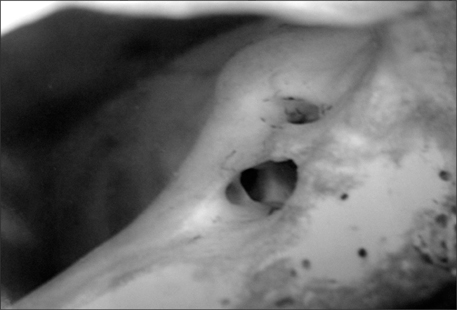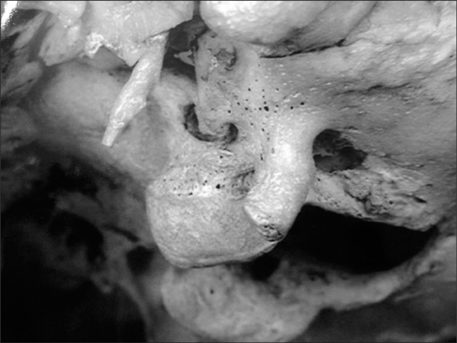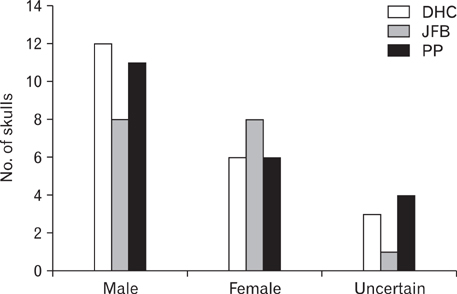Anat Cell Biol.
2012 Dec;45(4):268-273. 10.5115/acb.2012.45.4.268.
The study of hyperostosic variants: significance of hyperostotic variants of human skulls in anthropology
- Affiliations
-
- 1Department of Anatomy, VMMC and Safdarjung Hospital, New Delhi, India. drjasbirspall@gmail.com
- 2Esic Dental College, VMMC and Safdarjung Hospital, New Delhi, India.
- 3Department of Orthopaedics, VMMC and Safdarjung Hospital, New Delhi, India.
- 4Department of Anatomy, Lady Hardinge Medical College and Associated Hospital, New Delhi, India.
- KMID: 2133912
- DOI: http://doi.org/10.5115/acb.2012.45.4.268
Abstract
- Minor variations in the ossicles, foramina and ridges of the cranium have aroused the curiosity of anatomists for many decades. These non-metric variants help us to study the genetic relationships among ancient populations. Since these traits show considerable frequency differences in different populations, they can be used as anthropological characters in epidemiological studies. These variants indirectly reflect the part of underlying genotype of a given population thus implying their usefulness in biological comparisons of related groups. They can be used for the assessment of the existence of the parental structures within a community or as taxonomic indicators. For anthropological studies, the traits should be genetically determined, vary in frequency between different populations and should not show age, sex, and side dependency. The present study was conducted on hundred dry adult human skulls from Northern India. They were sexed and studied for the presence of hyperostotic traits (double hypoglossal canal, jugular foramen bridging, and paracondylar process). Sexual and side dimorphism was observed. None of the traits had shown statistically significant side and sexual dimorphism. Since the dimorphism is exhibited by none of them, it can be postulated that these traits are predominantly under genetic control and can be effectively used for population studies.
MeSH Terms
Figure
Cited by 1 articles
-
Morphological analysis and morphometry of the occipital condyle and its relationship to the foramen magnum, jugular foramen, and hypoglossal canal: implications for craniovertebral junction surgery
Pakpoom Thintharua, Vilai Chentanez
Anat Cell Biol. 2023;56(1):61-68. doi: 10.5115/acb.22.105.
Reference
-
1. Carolineberry A, Berry RJ. Epigenetic variation in the human cranium. J Anat. 1967. 101(Pt 2):361–379.2. De Villiers H. The skull of the South African negro: a biomedical and morphological study. 1968. Johannesburg: Witwatersrand University Press.3. Dodo Y. Non-metrical cranial traits in the Hokkaido Ainu and the northern Japanese of recent times. J Anthropol Soc Nippon. 1974. 82:31–51.4. Dodo Y, Ishida H. Population history of Japan as viewed from cranial nonmetric variation. J Anthropol Soc Nippon. 1990. 98:269–287.5. Ossenberg NS. The influence of artificial cranial deformation on discontinuous morphological traits. Am J Phys Anthropol. 1970. 33:357–371.6. Corruccini RS. An examination of the meaning of cranial discrete traits for human skeletal biological studies. Am J Phys Anthropol. 1974. 40:425–445.7. Pucciarelli HM. The influence of experimental deformation on neurocranial wormian bones in rats. Am J Phys Anthropol. 1974. 41:29–37.8. Berry AC. Factors affecting the incidence of non-metrical skeletal variants. J Anat. 1975. 120(Pt 3):519–535.9. Gottlieb K. Artificial cranial deformation and the increased complexity of the lambdoid suture. Am J Phys Anthropol. 1978. 48:213–214.10. Cosseddu GG, Floris G, Vona G. Sex and side differences in the minor non-metrical cranial variants. J Hum Evol. 1979. 8:685–692.11. Dodo Y. Appearance of bony bridging of the hypoglossal canal during the fetal period. J Anthropol Soc Nippon. 1980. 88:229–238.12. Dodo Y. Observations on the bony bridging of the jugular foramen in man. J Anat. 1986. 144:153–165.13. Graw M, Czarnetzki A, Haffner HT. The form of the supraorbital margin as a criterion in identification of sex from the skull: investigations based on modern human skulls. Am J Phys Anthropol. 1999. 108:91–96.14. Williams PL, Bannister LH, Berry MM, Collins P, Dyson M, Dussek JE, Fergusson MW. Gray's anatomy. 1995. New York: Churchill Livingstone;584.15. Dodo Y. A population study of the jugular foramen bridging of the human cranium. Am J Phys Anthropol. 1986. 69:15–19.16. Brothwell DR. The use of non-metrical characters of the skull in differentiating populations. Dtsch Ges Anthropol. 1958. 6:103–109.17. Grüneberg H. The pathology of development: a study of inherited skeletal disorders in animals. 1963. New York: Wiley.18. Searle AG. Genetical studies on the skeleton of the mouse. 9. Cases of skeletal variation within pure lines. J Genet. 1954. 52:68–102.19. Searle AG. Genetical studies on the skeleton of the mouse. 11. The influence of diet variation within pure lines. J Genet. 1954. 52:413–424.20. Deol MS, Truslove GM. Genetical studies on the skeleton of the mouse XX. Maternal physiology and variation in the skeleton of C57 BL mice. J Genet. 1957. 55:288–312.21. Howe WL, Parsons PA. Genotype and environment in the determination of minor skeletal variants and body weight in mice. J Embryol Exp Morphol. 1967. 17:283–292.22. Finnegan M, Cooprider K. Empirical comparison of distance equations using discrete traits. Am J Phys Anthropol. 1978. 49:39–46.23. Trinkaus E. Bilateral asymmetry of human skeletal non-metric traits. Am J Phys Anthropol. 1978. 49:315–318.24. Perizonius WR. Non-metric cranial traits: sex difference and age dependence. J Hum Evol. 1979. 8:679–684.25. Finnegan MJ. Population definition on the northwest coast by analysis of discrete character variation. 1972. Boulder: University of Colorado;PhD Dissertation.26. Gaherty G. Discrete traits, cranial measurements, and non-biological data in Africa. Am J Phys Anthropol. 1974. 40:136.27. Hakuba A, Hashi K, Fujitani K, Ikuno H, Nakamura T, Inoue Y. Jugular foramen neurinomas. Surg Neurol. 1979. 11:83–94.28. Prescher A, Brors D, Adam G. Anatomic and radiologic appearance of several variants of the craniocervical junction. Skull Base Surg. 1996. 6:83–94.29. Lombardi G. The occipital vertebra. Am J Roentgenol Radium Ther Nucl Med. 1961. 86:260–269.
- Full Text Links
- Actions
-
Cited
- CITED
-
- Close
- Share
- Similar articles
-
- The significance of CD44 variants expression in colorectal cancer and its regional lymph nodes
- Frequency of Benign Variants Associated with Hematologic Malignancy in the Catalogue of Somatic Mutations in Cancer
- Long-read sequencing of 12 samples discovered novel variants within human leukocyte antigen region
- Re-evaluation of the LDLR Gene Variants of Uncertain Significance Using ClinGen Guideline
- Application of Whole Exome Sequencing to Identify Disease-Causing Variants in Inherited Human Diseases






